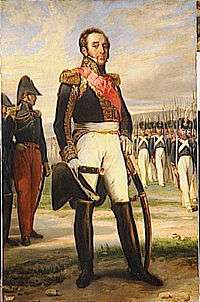Louis-Gabriel Suchet
| Louis Gabriel Suchet | |
|---|---|
.jpg) | |
| Born |
2 March 1770 Lyon, France |
| Died |
3 January 1826 (aged 55) near Marseilles, France |
| Allegiance |
|
| Service/branch | army |
| Years of service | 1792–1815 |
| Rank | Général de division |
| Battles/wars |
|
| Awards | Marshal of France |
| Other work | author |
Louis-Gabriel Suchet (2 March 1770 – 3 January 1826), Duke of Albufera (French: Duc d'Albuféra), was a Marshal of France and one of Napoleon's most brilliant generals.
Life

Suchet was born to a silk manufacturer in Lyon. He originally intended to follow his father's business but, serving as a volunteer in the cavalry of the National Guard at Lyon, he displayed abilities which secured rapid military promotions.[1]
In 1793, he was serving as a battalion chief (chef de bataillon) when he captured the British general Charles O'Hara at Toulon. During the 1796 Italian campaign, he was severely wounded at Cerea on 11 October. In October 1797, he was promoted to command of a half-brigade (demi-brigade). His services in the Tyrol under Joubert that year and in Switzerland under Brune over the next were recognized by his promotion to the rank of brigadier general (général de brigade). He took no part in the Egyptian campaign but was made Brune's chief of staff in August and restored the efficiency and discipline of the army in Italy. In July 1799, he was promoted to division general (général de division) and made Joubert's chief of staff in Italy. In 1800, he was named second-in-command to Masséna. His dexterous resistance to the superior forces of the Austrians with the left wing of Masséna's army, when the right and centre were shut up in Genoa, not only prevented the invasion of France from this direction but contributed to the success of Napoleon's crossing the Alps, which culminated in the battle of Marengo on 14 June. He took a prominent part in the rest of the Italian campaign up to the armistice of Treviso.[1]
In the campaigns of 1805 and 1806, he greatly enhanced his reputation at the Battles of Austerlitz, Saalfeld, Jena, Pułtusk, and Ostrolenka, in the last of which he commanded an infantry division. He obtained the title of count on 19 March 1808. Ordered to Spain, he took part in the Siege of Saragossa, after which he was named commander of the army of Aragon and governor of that region. Within two years, he brought the area into complete submission by wise and adroit administration no less than by his brilliant valor. Beaten by the Spanish at Alcañiz, he sprung back and soundly defeated the army of Blake y Joyes at María on 14 June 1809. On 22 April 1810, he defeated O'Donnell at Lleida. After the siege of Tarragona, he was named marshal of France on 8 July 1811. In 1812, he captured Valencia,[1] for which he was rewarded with the dukedom of Albufera nearby, on 24 January.[2] When the tide turned against France, Suchet defended his conquests one by one until compelled to withdraw from Spain, after which he took part in Soult's defensive campaign of 1814.[1]
The restored Bourbon king Louis XVIII made him a peer of France on 4 June with a seat in the upper house, but this was forfeited (effective 24 July 1815) by his support of Napoleon's return during the Hundred Days. During Napoleon's brief restoration, Suchet was given command of an army on the Alpine frontier.[1]
He died in the Castle of Saint-Joseph[3] near Marseille on 3 January 1826.[1]
Legacy
He wrote his memoirs (Mémoires sur Ses Campagnes en Espayne) in two volumes from 1829 to '34.[1]
The chicken dish poularde à la d'Albuféra is named after him.
Family
He married Honorine Anthoine de Saint-Joseph (Marseille, 26 February 1790 – Paris, 13 April 1884), a niece of Julie Clary, the wife of Joseph Bonaparte, on 16 November 1808. They had three children:
- Louise-Honorine (1811 – 1885)
- Louis-Napoleon (1813 – 1877)
- Anne-Marie (1820 – 1835)
See also
References
Citations
Bibliography
- "Louis Gabriel Suchet, Duc d'Albufera", Encyclopædia Britannica, 9th ed., Vol. XXII, New York: Charles Scribner's Sons, 1887, p. 617.
- "Louis Gabriel Suchet", Encyclopædia Britannica, 11th ed., Vol. XXVI, Cambridge: Cambridge University Press, 1911, p. 7.
- St. Cyr-Nogues, ed. (1829–34), Mémoires. (French)
- Kautz, Pete, ed. (2007), Memoirs of the War in Spain, London: Henry Colburn, ISBN 1-85818-477-0.
.svg.png)